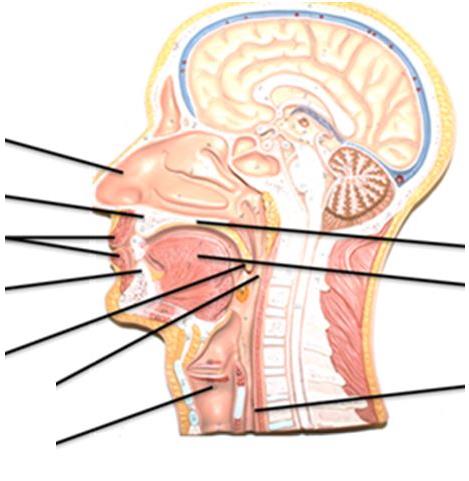Review Questions
1. Select the word which best fits each statement below.
Ingestion Digestion Absorption Defecation Alimentary canal
Uvula Hard palate Tonsils Submucosa Gastroesophageal
Visceral Parietal Peritoneum Accessory organs Muscularis externa
1. Lymphoid tissue involved in both digestive and respiratory tracts. __________________
2. Serous membranes of the abdominal cavity. __________________
3. Another name for the Gastrointestinal tract. __________________
4. The second layer of the GI tract. __________________
5. Forms the roof of the oral cavity. __________________
6. Pancreas, liver and salivary glands. __________________
7. The last process involved in the digestive system. __________________
8. Taking-up of digested material. __________________
9. Prevents food from getting into the nasal cavity. __________________
10. The peritoneum attached to the organs in the abdominal cavity. __________________
11. The peritoneum attached to the abdominal wall. __________________
12. Breakdown of food physically or chemically. __________________
13. The region where the esophagus and the stomach connect. __________________
14. The layer of the GI tract where there are different layers of muscles. __________________
15. Taking of food into the buccal cavity. __________________
2.0 Select the word which best fits each statement below. Write the number of the correct word in the space provided.
1. Pharynx ___________ the third part of the small intestine
2. Cheeks ___________ the connection between the oral cavity and the stomach
3. Pylorus ___________ connects the stomach to the liver.
4. Ileum ___________ muscular region forming the back of the oral cavity.
5. Large intestine ___________ The top part of the stomach
6. greater omentum ___________ forms the lateral wall of the oral cavity
7. Lingual ___________ Where most absorption of nutrients occur.
8. Esophagus ___________ The first layer of the GI track.
9. Duodenum ___________ mesentery attached to the greater curvature of the stomach.
10. Lesser omentum ___________ where the most water is reabsorbed.
11. Fundus ___________ these tonsils are closer to the tongue.
12. Jejunum ___________ where the enzymes from the pancreas are released.
13. Mucosa ___________ The last segment of the stomach.
3.0 Identify the accessory organ described. Write the name of the organ is the space provided.
1. The largest salivary gland. ________________________
2. Produces bile. ________________________
3. Where bile is stored. ________________________
4. Produces the most digestive enzymes. ________________________
5. Enamel and dentin are part of this organ. ________________________
6. Very muscular with taste buds. ________________________
7. Empties its content together with the pancreas. ________________________
8. Three pairs of these. ________________________
9. Made up of the hardest material found in the body. ________________________
10. Involved in metabolism and bile production. ________________________
11. Each one has a root and a crown. ________________________
12. Produces salivary amylase. ________________________
4.0 Label the following structures
5.0 Label the following structures
6. Label the following
7.0 List the structures and organs involved in ingestion of food until the leftover of undigested food is eliminated. List in order and indicate where chemical and physical breakdown and absorption of nutrients take place.
8.0 Give the dental formula for
a) Infant
b) adult






